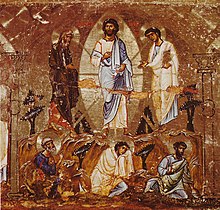
Glory and the Cross – The Transfiguration, located between two announcements by Jesus of his approaching Passion, takes place on a high mountain before Peter, James and John, the Apostles whom we will find in agony in Gethsemane. We sense a link between the glory manifested here and the Cross that awaits Jesus.
A mysterious event
The Transfiguration is an unspeakable experience. It can only be described through comparisons: Jesus’ face shines like the sun and his garments become white like light, of such a whiteness that no fuller on earth can whiten like this. The mystery intensifies with the appearance of the two witnesses of the Old Testament: Moses and Elijah who, according to the Fathers of the Church, symbolize the Law and the Prophets. The luminous cloud evokes the cloud that protected the march in the desert of the people of Israel, leaving the slavery of Egypt for the promised land – the cloud of God’s manifestations in the Old Testament. From this cloud, which tradition has identified with the Holy Spirit, resounds the voice of the Father who confirms the Son’s mission with regard to all men: “Listen to him”. Saint Francis de Sales draws our attention to this injunction of the Father: “listen to him” indicating that it is obedience to the Father to follow Our Lord to hear his word (Sermon IV).
A decisive revelation
The Transfiguration is a central stage of revelation in that it is a Trinitarian event that manifests the divinity of Jesus, “the true light that enlightens every man” (Jn 1:9); it prefigures his Resurrection; it reveals to us the glorification to which we ourselves are called by the grace of God; it announces the final transfiguration of the entire Cosmos. According to this commentary of St. Francis de Sales: “He showed us a small sample of eternal happiness and a small drop of that ocean and sea of incomparable bliss to make us desire the whole play” (Sermon LVII).
A call to contemplation
Saint Pope John Paul II introduced it into the Rosary as a luminous mystery in 2002, writing in his letter Rosarium Virginis Mariae: “The Gospel episode of the transfiguration of Christ, in which the three Apostles Peter, James and John appear as rapturous by the beauty of the Redeemer, can be considered an icon of Christian contemplation.” (RVM 9)
St. Francis de Sales, commenting on what St. Matthew relates: “The apostles having risen (for they fell on their faces when they heard the voice of the eternal Father), saw only Jesus alone,” remarks that this is the supreme degree of perfection, to see only Our Lord in whatever we do (Sermon IV).
Strength in hardships
Our holy Pope John Paul II, in his Apostolic Exhortation Vita Consecrata in 1996, emphasized how the contemplation of Christ in his Transfiguration can illuminate our daily life, made up of graces and trials: “the disciples who have enjoyed the intimacy of the Master, a moment enveloped in the splendour of the Trinitarian life and in the communion of saints, are as if swept away into eternity. Then they are suddenly brought back to everyday reality; they no longer see only ‘Jesus alone’ in the humility of human nature and they are invited to return to the valley, to share in his efforts in the realization of God’s plan and to take the way of the Cross with courage. (VC 14)
A multifaceted mystery
Meditation on the mystery of the Transfiguration can lead us to an ever more luminous knowledge of our Lord Jesus, of his plan of love for us, of his work of salvation and of our profound vocation. On a daily basis, it can illuminate the trials of our lives with all its weight of hope.
Source: The Transfiguration – Association Saint François de Sales (saint-francois-de-sales.com)